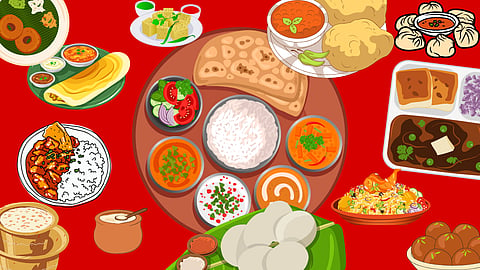

India’s rich culinary heritage is packed with sustainable wisdom. Yet food waste remains a major challenge across farms, homes, and restaurants. This guide explores how traditional Indian cooking and modern eco-friendly habits can work together to reduce waste and build a more sustainable food system.
Food waste is a global challenge with significant environmental, economic, and social implications. In India, despite its rich culinary traditions that often emphasize resourcefulness and minimal waste, a substantial amount of food is still lost or wasted at various stages, from farm to fork. However, the inherent wisdom embedded in traditional Indian cooking practices, coupled with modern sustainable approaches, offers a powerful framework for reducing food waste and promoting a more sustainable food system. This comprehensive guide will explore the intersection of Indian food and sustainability, highlighting practical strategies, traditional wisdom, and innovative solutions for reducing food waste in Indian kitchens and beyond, empowering you to make a positive impact from your plate to the planet.
The Scale of Food Waste in India
India ranks among the top countries for food waste globally. Factors contributing to this include:
Traditional Indian Wisdom for Reducing Food Waste
Many age-old Indian culinary practices are inherently sustainable and designed to minimize waste:
1. Nose-to-Tail / Root-to-Stem Cooking
Traditional Indian cooking often utilizes every edible part of an ingredient. For example, banana stems, peels of gourds, and even seeds are often incorporated into dishes.
2. Pickling and Preserving
India has a rich tradition of pickling (achar), fermenting, and drying fruits and vegetables to extend their shelf life, especially during gluts.
3. Portion Control and Thali System
The traditional thali system, where a balanced meal is served in small, distinct portions, encourages mindful eating and reduces over-serving.
4. Reusing Leftovers Creatively
Indian kitchens are masters of transforming leftovers into new, delicious dishes.
Modern Strategies for Reducing Food Waste in Indian Homes
1. Smart Shopping and Meal Planning
Plan your meals for the week and create a shopping list based on what you need. Avoid impulse purchases.
Tip: Check your pantry and fridge before shopping. Buy fresh produce in smaller, more frequent quantities if possible.
2. Proper Food Storage
Store fruits, vegetables, and cooked food correctly to extend their freshness.
Tip: Store leafy greens in airtight containers with a paper towel, keep root vegetables in a cool, dark place, and refrigerate cooked food promptly.
3. Understanding Expiry Dates
Differentiate between ‘best by’ (quality) and ‘use by’ (safety) dates. Many foods are still safe to eat after their ‘best by’ date.
4. Composting Food Scraps
For unavoidable food waste (like peels, cores, and spoiled food), composting is an excellent way to return nutrients to the soil and reduce landfill waste.
Tip: Start a home compost bin or participate in community composting programs. Even a small balcony compost can make a difference.
5. Donating Excess Food
If you have excess edible food that you won't consume, consider donating it to local food banks, shelters, or community kitchens.
6. Supporting Sustainable Food Systems
Choose to buy from local farmers, farmers' markets, or brands that prioritize sustainable and ethical practices.
Tip: Look for organic certifications, fair trade labels, and support community-supported agriculture (CSA) initiatives.
Reducing food waste in India is a collective responsibility, from producers to consumers. By embracing traditional wisdom, adopting modern sustainable practices, and making conscious choices in our kitchens and dining habits, we can significantly contribute to a more efficient, equitable, and environmentally friendly food system. Let every meal be a step towards a sustainable future!
